Physical Address
304 North Cardinal St.
Dorchester Center, MA 02124
Adipocytic tumors represent an extremely heterogeneous category of clinically and morphologically distinctive lesions, sharing variable amounts of lipomatous differentiation. Some of them (i.e., benign lipomas and well-differentiated liposarcoma [WDLPS]) are among the most commonly encountered mesenchymal neoplasms. As will be discussed in depth, diagnostic criteria have been evolving constantly, in part because of the contribution of cytogenetics and molecular genetics. These techniques have not only offered insights into the pathogenesis of many lesions but also have become valuable confirmatory diagnostic tools because the vast majority of the entities discussed in this chapter harbor specific chromosomal abnormalities.
Many adipocytic tumors present diagnostic challenges. Diagnostic difficulties are caused by the rarity of some entities (e.g., chondroid lipoma) as well as the significant morphologic overlap among these clinically and biologically distinctive lesions (e.g., benign lipoma and atypical lipomatous tumor [ALT]/WDLPS). Another potential source of diagnostic confusion has been generated by inconsistent application of terminology that has led to a significant degree of uncertainty among both pathologists and clinicians. The previous classification of mesenchymal tumors issued by the World Health Organization (WHO) in 2002 has offered semantic clarifications that are useful to enumerate. First of all, it has been made clear that the terms ALT and WDLPS are synonyms because they refer to lesions that are identical morphologically and genetically. The use of one term rather than the other depends only on the anatomic location. For surgically amenable lesions, the less aggressive designation ALT is preferable, whereas the term WDLPS is used when dealing with deep-seated masses at central body sites, such as the retroperitoneum, mediastinum, and spermatic cord.
The current classification of mesenchymal tumors, issued by the WHO in 2013, has introduced minimal changes in the category of adipocytic tumors, among which are: (1) the abolition of the term “round cell liposarcoma” (in 2002 the entity had already been incorporated into the myxoid liposarcoma category), recognizing the fact that it merely represents an inaccurate description of high-grade myxoid liposarcoma; and (2) the deletion of the label “mixed type liposarcoma,” as it most likely corresponds to unusual morphological patterns (most often myxofibrosarcoma-like) of dedifferentiated liposarcoma.
As has already been alluded to, the interplay between morphology and genetics has greatly contributed to the field of adipocytic neoplasia, and the diagnostic workup of fatty tumors in some cases may incorporate both conventional cytogenetics and molecular genetics. However, unsophisticated techniques, such as gross sampling and microscopic examination of hematoxylin and eosin–stained slides, still represent the diagnostic mainstay in this group of tumors. The importance of proper gross sampling will be discussed in depth whenever relevant, but in general, gross examination should not be delegated to inexperienced individuals because this may hamper the diagnostic process. In addition, proper orientation of the surgical specimen (best if performed with the surgeon) and identification of the closest margins are key steps that should be performed accurately.
Last but not least, proper classification (inclusive of molecular data) may play a fundamental role in predicting the response to innovative therapeutic approaches. For example, molecular targeting of MDM2 and or CDK4-expressing neoplasms (e.g., dedifferentiated liposarcoma) and the exquisite sensitivity of myxoid liposarcoma to the relatively new compound trabectedin show the importance of correct partitioning of liposarcomas.
Benign solitary lipoma, a proliferation of mature white fat, is the most commonly encountered human mesenchymal neoplasm. In a small fraction of patients (~5% of all benign lipomatous tumors), lipomas present as multiple lesions. This condition is generally kept distinct from lipomatosis, an even rarer disease in which a diffuse overgrowth of fatty tissue is observed.
Benign lipoma most often occurs as a subcutaneous solitary mass in adults between the fourth and sixth decades. Men are more frequently affected than women, and obese patients tend to have lipomas with higher frequency than the normal population. Lipomas can arise at any anatomic location and can involve both superficial and deep soft tissues. Not infrequently, they can occur within or between skeletal muscles, in which case they are labeled as intramuscular and intermuscular lipomas, respectively. The most frequently affected anatomic sites for this subgroup are the large muscles of the thigh, shoulder, and upper arm. Benign lipomas can also be encountered in the head and neck region and at visceral sites in the submucosa of the small and large bowel. More rarely, lipomas can be observed in the respiratory tract. Specific subsets of lipomas are represented by dermal lipoma and synovial lipoma. Dermal lipomas most often occur as pedunculated, skin tag–like lesions. When they are multiple and located around the lower limb girdle, the term nevus lipomatosus superficialis has traditionally been applied (see also Chapter 15 ). Synovial lipoma is also known as lipoma arborescens , a designation that reflects the villous-like gross appearance of this lesion arising in the joint space. Synovial lipoma occurs in adults and is almost always associated with inflammation and synovial hyperplasia. Both features support the possible reactive nature of this distinctive lipomatous proliferation. Very rarely, benign lipomas present as primary intraosseous lesions. In principle, a diagnosis of benign lipoma in the abdomen or retroperitoneum should be made with extreme caution and with the support of ancillary techniques. Common experience shows that most often those lesions actually represent WDLPS.
Clinically, most solitary lipomas present as a painless mass of long duration. Multicentricity is observed in approximately 5% of patients. Multiple lipomas tend to cluster in the upper half of the body. Interestingly, one third of the patients presenting with multiple lipomas appear to inherit the disorder in an autosomal dominant manner.
Rarely, patients present with a diffuse overgrowth of morphologically benign adipose tissue known as lipomatosis that most often affects the extremities and the trunk. Clinically, lipomatosis is subclassified into symmetric, asymmetric, pelvic, and mediastino-abdominal forms. Symmetric lipomatosis, also known as Madelung disease or Launois-Bensaude syndrome , most often affects adult patients of Mediterranean origin. Clinically, it presents as a massive, ill-defined lipomatous overgrowth localized at the neck and extending deeply into the muscular structures of the region. Asymmetric lipomatosis affects large portions of the extremities, the trunk, and rarely the viscera, and may be associated with gigantism of the involved anatomic segment. Pelvic lipomatosis is characterized by a diffuse adipose tissue overgrowth in the pelvic region associated with compression of the urinary tract, sigmoid colon, and rectum.
Grossly, solitary benign lipomas are usually well circumscribed, are surrounded by a thin capsule, and feature a yellow cut surface. Maximum size depends on the anatomic location and ranges from 1 cm to 5 cm for superficial lesions, whereas deep-seated lesions may attain larger dimensions.
The microscopic hallmark of benign lipomas is a uniform proliferation of mature adipocytes with minimal or no variation in size and shape ( Fig. 12.1 ). Secondary changes are relatively frequent, including foci of fibrosis and microscopic fat necrosis, with foamy histiocytes and multinucleated giant cells ( Fig. 12.2 ). Occasionally, metaplastic bone or cartilage ( osteolipoma and chondrolipoma ), as well as extramedullary hematopoiesis, can be observed. Lipomas can contain fibrous tissue and show myxoid change to the extent that the use of terms such as fibrolipoma and myxolipoma , respectively, can be justified. Intramuscular lipomas harbor skeletal muscle fibers showing variable degrees of atrophy ( Fig. 12.3 ). Most intramuscular lipomas are infiltrative, whereas a minority (not exceeding 10%) of these tumors appear to be well demarcated. The same diagnostic criteria used for ordinary lipomas must be applied, and it is of particular importance to exclude nuclear atypia in both adipocytes and stromal cells, all features favoring a diagnosis of ALT/WDLPS.
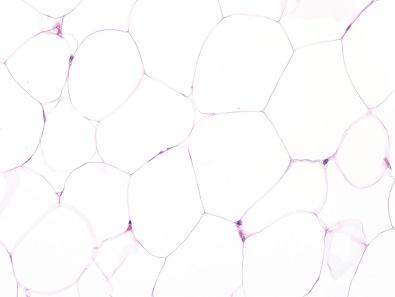
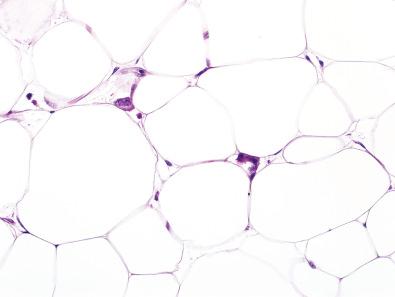
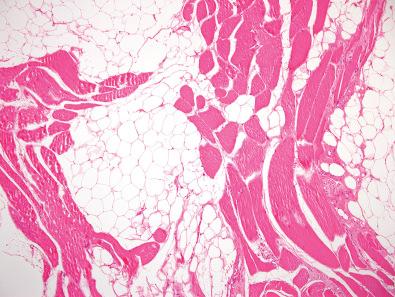
Benign lipomas are diffusely positive for S-100 protein; however, this finding is not diagnostically relevant.
Solitary benign lipomas feature an abnormal karyotype in approximately half of cases. Three main categories are identified: (1) rearrangements of the 12q13-15 region mostly with 3q22; (2) deletion of 13q; and (3) rearrangement of 6p21-23. The target gene in 12q13-15 is HMGA2 , which encodes a member of the high-mobility group (HMG) protein family.
The diagnosis of benign lipomas (including intra- and intermuscular forms) is usually straightforward. However, the distinction from the adipocytic variant of ALT/WDLPS can occasionally be difficult. Diagnostic clues favoring a diagnosis of lipoma are the complete absence of cytologic atypia in both adipocytes and stromal cells as well as the uniform size of fat cells. The absence of lipoblasts (i.e., uni- or multivacuolated cells harboring a hyperchromatic, atypical scalloped nucleus) is not a helpful finding, because lipoblasts can be absent in ALT/WDLPS. A relatively common diagnostic pitfall is the presence of fat necrosis, a condition in which significant variation in cell size is observed as a consequence of inflammation ( Fig. 12.4 ). Therefore, the differential diagnosis with ALT/WDLPS can be raised. The presence of foamy histiocytes as well as occasional multinucleated giant cells and the absence of nuclear atypia are the two most important diagnostic criteria. In addition, MDM2/CDK4 overexpression and amplification are never observed in benign lipomas, whereas they are usually present in ALT/WDLPS. Evaluation of MDM2 immunohistochemistry in differentiated adipocytic neoplasms is sometimes challenging; it has been suggested that in such cases fluorescence in situ hybridization (FISH) analysis may be a more valuable diagnostic tool.
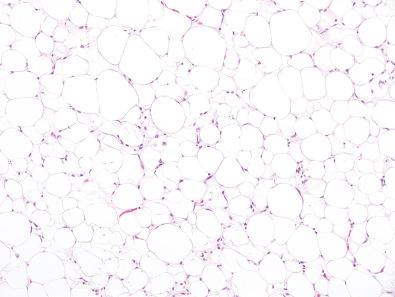
Not infrequently, intramuscular lipoma must be distinguished from intramuscular angioma (see Chapter 13 ), which, in addition to a complex vascular network, frequently features a prominent adipocytic component and fatty atrophy of muscle fibers, leading to diagnostic confusion ( Fig. 12.5 ). The recognition of the abnormal vascular component is the most important diagnostic clue.
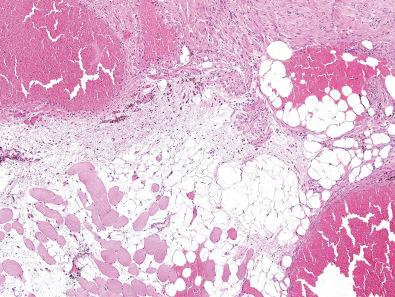
Lipomas are benign mesenchymal lesions whose complete local excision is curative. A 5% local recurrence rate is reported. In contrast, intramuscular lipomas are characterized by a significant incidence of local recurrence (approximately 20%) that can be avoided only by complete removal of the involved muscle.
Lipofibromatosis is a diffuse spindle cell proliferation typically occurring in childhood that is associated with a mature adipocytic component. Lipofibromatosis should be kept separate from the clinically, morphologically, and genetically distinct entity known as infantile (desmoid) fibromatosis (see Chapter 4 ).
Clinically, lipofibromatosis occurs in the pediatric population, with a peak incidence in the first decade. Not infrequently, this lesion can be detected at birth. The most common anatomic locations are the hand and upper and lower limbs, followed by the feet, trunk, and head and neck region. In the original description by Fetsch and colleagues, patient age ranged from 11 days to 12 years, with a median age of 1 year. Occasionally, an association with macrodactyly has been reported.
Grossly, lipofibromatosis tends to be poorly circumscribed, with a yellow-gray, variegated cut surface. Histologically, a spindle cell fibroblastic or myofibroblastic proliferation organized in fascicles is observed ( Fig. 12.6 ). Neoplastic cells tend to grow along fibrous septa and are associated with an abundant adipocytic component ( Fig. 12.7 ). Cytologic atypia is generally absent.
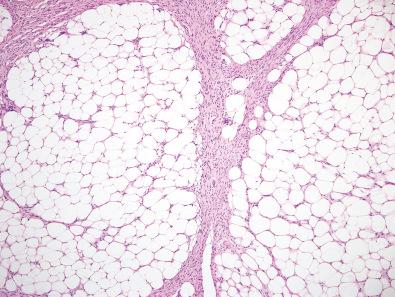
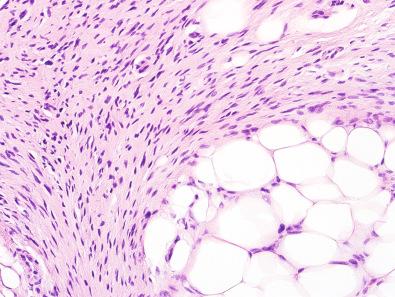
Immunohistochemistry does not play a major role in the diagnosis of lipofibromatosis. Variable, focal immunoreactivity for CD99, CD34, α-smooth muscle actin, bcl-2, and less frequently, S-100 protein has been reported, whereas desmin is negative.
A three-way t(4;9;6) translocation has been reported in a single case of lipofibromatosis.
The differential diagnosis includes fibrous hamartoma of infancy and desmoid fibromatosis. Lipofibromatosis lacks the distinctive organoid growth pattern, with primitive, myxoid nodules, characteristic of fibrous hamartoma. Desmoid fibromatosis lacks the adipocytic component of lipofibromatosis and is characterized by long fascicles of uniform spindle cells set in a heavily collagenous stroma. Nuclear immunopositivity for β-catenin is frequently observed in desmoid fibromatosis, which is helpful for confirming the diagnosis. Recently, a group of locally aggressive soft tissue tumors of children and young adults with distinctive lipofibromatosis-like morphology, S-100 protein immunopositivity, and NTRK1 gene fusions has been described.
Persistent disease or nondestructive local recurrence is observed in more than two thirds of cases of lipofibromatosis and seems to correlate with congenital onset, distal anatomic location, incomplete excision, and possibly mitotic activity in the spindle cell component.
Lipomatosis of nerve, also known as fibrolipomatous hamartoma of nerve or neural fibrolipoma , is a fibrolipomatous proliferation of epineurium most often occurring in the median nerve, with consequent enlargement of the affected anatomic compartment.
Lipomatosis of nerve most often arises in the median nerve (followed by the ulnar, radial, peroneal, and cranial nerves) of young adults, with a peak incidence between the first and third decades; however, it can be present at birth. Approximately one third of affected patients show macrodactyly. Expansion of the lesion is associated with compression neuropathy, causing local pain in half of affected patients.
Grossly, a soft, fusiform enlargement of the affected nerve and its branches is seen, with a yellow cut surface as a consequence of the abundant adipocytic component. Histologically, a mature adipocytic proliferation, variably associated with a fibrous component, infiltrates and expands the epineurial and perineurial compartments of the affected nerves ( Figs. 12.8 and 12.9 ). Concentric perineurial fibrosis is invariably present, whereas microfasciculation (“pseudo-onion bulb” formation, in which perineurial cells grow in concentric layers surrounding axons) is more rarely encountered.
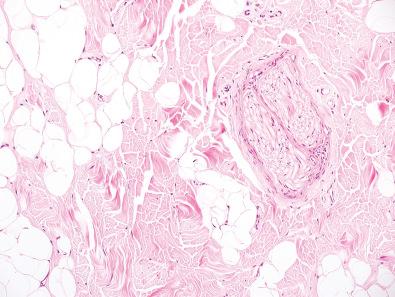
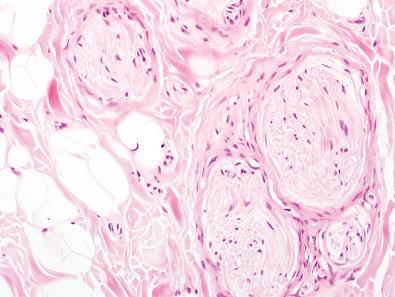
Immunohistochemistry is helpful only to highlight the various components of nerve fibers and the absence of proliferation of the neural/perineurial component, which instead tends to appear atrophic.
Microfasciculation may occasionally raise the differential diagnosis of intraneural perineurioma, a rare, distinctive clinicopathologic entity characterized by an intraneural neoplastic proliferation of epithelial membrane antigen (EMA)–positive perineurial cells, most often arising in the upper extremities of young adults.
Lipomatosis of nerve is a benign lesion whose local excision may lead to severe functional damage, sometimes greater than that generated by the disease itself. Conservative, nerve-sparing surgical approaches are therefore recommended.
Angiolipoma is a relatively common, small, benign subcutaneous adipocytic lesion with a variably prominent capillary-sized vascular network. Patients frequently present with multiple lesions that can be painful, especially on palpation.
Angiolipoma usually occurs as multiple (solitary in only one third of patients), painful subcutaneous nodules, most often arising in the upper limbs (approximately two thirds are seen in the forearm), trunk, and lower limbs of young adults. Angiolipomas most often occur sporadically, but in a minority of cases a family history can be identified.
Peak incidence is between the second and third decades. They most frequently affect men. Deep-seated lesions, in the past called infiltrating angiolipomas , instead represent intramuscular angioma, a lesion in which an adipocytic component is frequently observed (see Chapter 13 ).
Grossly, angiolipomas are well-circumscribed, encapsulated nodular lesions, most often smaller than 2 cm. The cut surface shows variation in color from yellow to red, depending on the relative proportions of adipocytic and vascular components. Histologically, angiolipomas have a mature adipocytic proliferation variably associated with a vascular component. The vascular network is predominantly composed of a capillary-sized proliferation that tends to be more prominent at the periphery ( Fig. 12.10 ). Characteristically, the blood vessels contain fibrin microthrombi, an almost unique morphologic feature of angiolipoma ( Fig. 12.11 ). The amount of capillary proliferation can vary from minimal to predominant (cellular angiolipoma) , and the adipocytic nature of the lesion may be overlooked ( Fig. 12.12 ).
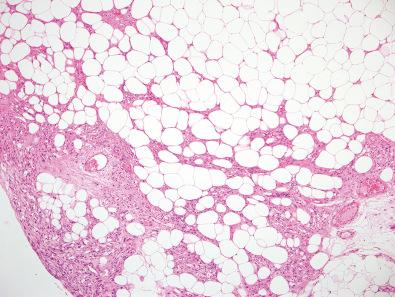
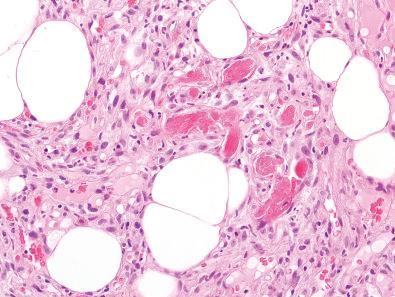
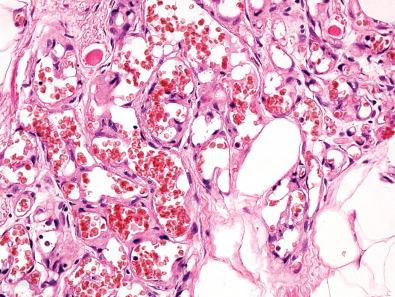
S-100 protein immunopositivity is observed in the adipocytic component, whereas endothelial markers, such as CD31 and CD34, highlight the capillary network. However, immunohistochemistry generally does not play a role in the diagnosis.
Cytogenetically, angiolipomas are almost unique among adipocytic neoplasms because they are the only entity in which the search for karyotypic abnormalities has failed. The only exception is one case in which a t(X;2) has been documented in 1 of 5 angiolipomas. A recent study identified frequent PRKD2 mutations in angiolipomas.
Clinically, local pain is observed not only in angiolipoma but also in other histologically unrelated subcutaneous nodular lesions, such as angioleiomyoma, eccrine spiradenoma, schwannoma, and glomus tumor (“five painful nodules of the subcutis”). Histologically, most diagnostic difficulties arise with lesions lying at the extremes of the morphologic spectrum, in which the vascular component can be minimal, and therefore overlooked, or predominant (cellular angiolipoma) to the extent that a capillary hemangioma or even Kaposi sarcoma may be considered in the differential diagnosis. Lack of immunostaining for human herpesvirus-8 (HHV8) is particularly useful in excluding Kaposi sarcoma.
Angiolipomas are benign lesions. Local excision is curative, with no recurrences reported.
Spindle cell lipoma and pleomorphic lipoma have been generally regarded as separate (but related) entities. However, the concept that spindle cell/pleomorphic lipoma actually represents a spectrum of benign adipocytic neoplasms, all sharing clinical, morphologic, immunophenotypic, and genetic features, has recently gained broad acceptance. In the past, some confusion was generated by the use of the term atypical lipoma as a synonym for pleomorphic lipoma. As mentioned, the terms atypical lipoma and ALT are alternative designations for WDLPS arising in surgically amenable soft tissue sites. ALT/WDLPS is clinically, morphologically, and genetically distinct from pleomorphic lipoma.
Spindle cell/pleomorphic lipoma typically occurs as a painless subcutaneous mass, most often less than 5 cm in diameter, located on the posterior aspect of the neck or upper back of middle-aged men (men outnumbering women 10:1), with a peak incidence between the fourth and fifth decades. The face, orbital region, and oral cavity are more rarely affected. Uncommonly, spindle cell lipoma can be observed at a purely dermal location (see Chapter 15 ), which shows a more ubiquitous anatomic distribution. Subcutaneous spindle cell/pleomorphic lipoma has rarely been diagnosed outside the back and head and neck regions ; however, caution is recommended when making such a diagnosis outside the context of the typical clinicopathologic presentation, in particular, when dealing with deeply situated masses. Common experience indicates that most (if not all) of these lesions represent ALT/WDLPS. Spindle cell lipomas can present as multiple lesions and also occur as a familial disease.
Grossly, spindle cell/pleomorphic lipoma is usually well circumscribed, but less well demarcated than ordinary lipomas. The cut surface varies from yellow to white-gray, depending on the relative amount of adipocytic and spindle cell components. Focal to diffuse myxoid change can be observed.
Histologically, classic forms of spindle cell lipoma are composed of a cytologically bland spindle cell proliferation admixed with a variable amount of mature adipocytes ( Fig. 12.13 ). Fibromyxoid stroma with brightly eosinophilic, coarse (“ropy”) collagen fibers is one of the most important morphologic hallmarks of the lesion ( Fig. 12.14 ). The amount of the spindle cell component is extremely variable, with some cases featuring rare adipocytes (“cellular spindle cell lipoma”) ( Fig. 12.15 ). The degree of variation in adipocyte size is often greater than is seen in ordinary lipoma. Not infrequently, myxoid stromal change is present, which may be a source of diagnostic confusion, most often with myxofibrosarcoma and myxoid liposarcoma ( Fig. 12.16 ). When myxoid change becomes prominent, the formation of angiectoid spaces may result in a pseudoangiomatous growth pattern. Most likely, the lesion described as dendritic fibromyxolipoma actually corresponds to examples of spindle cell lipoma with prominent myxoid change. As already mentioned, pleomorphic lipoma represents part of the spectrum of this entity, in which bizarre, hyperchromatic, and sometimes multinucleated cells are associated with the otherwise typical morphologic features of spindle cell lipoma ( Fig. 12.17 ). In classic cases, multinucleated giant cells show a floret-like appearance ( Fig. 12.18 ). Interestingly, occasional lipoblasts may be seen, underscoring the idea that lipoblasts are not exclusive to liposarcoma.
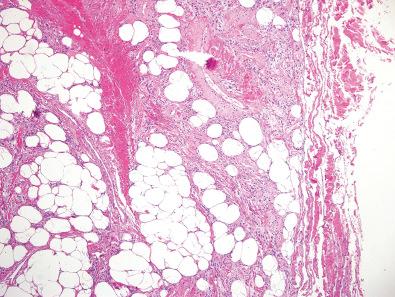
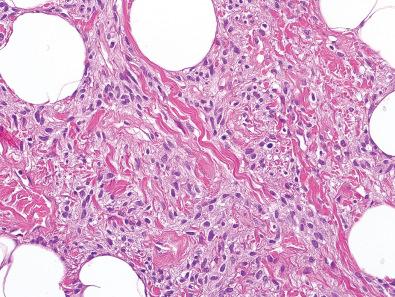
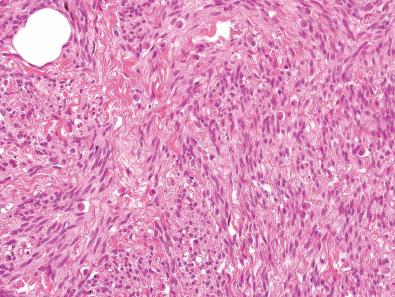
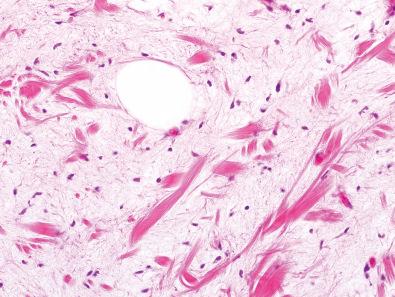
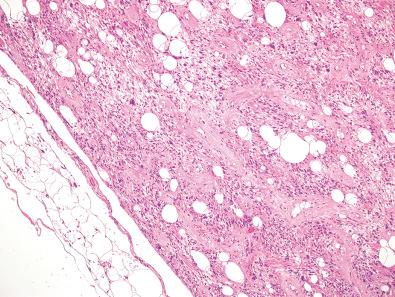
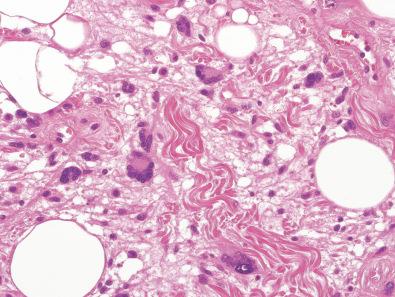
Spindle cell lipoma is characterized by diffuse positivity for CD34. CD10 immunoreactivity has also been reported. Similar to CD34, CD10 expression appears to be much more widespread than was initially believed (and is therefore of dubious diagnostic utility). Recently, loss of nuclear expression of retinoblastoma protein (Rb) has been reported in spindle cell/pleomorphic lipoma.
Cytogenetic analysis of spindle cell/pleomorphic lipoma cases has demonstrated consistent deletions of the long arm of chromosome 13, often in combination with loss of the long arm of chromosome 16. These genetic features support distinction from both ordinary lipoma and ALT/WDLPS. Interestingly, the same alteration is seen in a morphologically similar entity know as mammary (or mammary-type) myofibroblastoma, as well as in cellular angiofibroma (see Chapters 3 and 17 ) ; all of these lesions show loss of Rb expression.
The greatest morphologic overlap is with mammary-type myofibroblastoma, a benign lesion that shares the same karyotypic alterations with spindle cell lipoma. Originally reported in the breast, this lesion may also arise in the soft tissues, most often in the inguinal region of middle-aged men, with a peak incidence in the fifth decade and a male predominance. Ironically, mammary-type myofibroblastoma is far more common at extramammary sites (mammary location accounts for ~10% of cases), and in addition to the groin, it may occur in the limbs, trunk and axilla. Mammary-type myofibroblastoma is well circumscribed and composed of a cellular, cytologically bland, spindle cell proliferation in a collagenous stroma containing the same ropy collagen bundles as seen in spindle cell lipoma ( Fig. 12.19 ). The presence of adipocytes in variable amounts makes the resemblance to spindle cell lipoma even greater. Numerous scattered mast cells are generally part of the typical morphologic picture. In contrast to spindle cell lipoma, a more fascicular architecture is generally observed in mammary-type myofibroblastoma, and strong desmin immunopositivity is usually detected ( Fig. 12.20 ). Loss of nuclear expression of Rb is observed in approximately 90% of cases, further highlighting the genetic link with spindle cell lipoma.
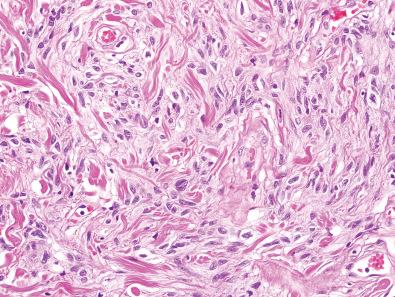
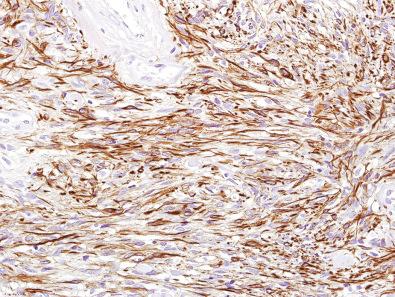
As discussed earlier, extensive myxoid change may raise the differential diagnosis of myxoid liposarcoma. However, spindle cell lipoma lacks the typical plexiform, capillary-sized (crow's feet) vascular network that is one of the diagnostic hallmarks of myxoid liposarcoma. Spindle cell lipoma also lacks the specific translocations involving the DDIT3 gene that are characteristic of myxoid liposarcoma. Low-grade myxofibrosarcoma can also be mistaken for myxoid spindle cell lipoma; however, myxofibrosarcoma is almost always multinodular, featuring a highly distinctive curvilinear vascular pattern as well as a markedly atypical, pleomorphic neoplastic cell population. The differential diagnosis with atypical spindle cell lipomatous tumor is discussed later in the chapter; however, this distinction is based primarily on the absence of nuclear atypia.
Pleomorphic lipoma can be a diagnostic challenge, mostly because of the presence of often striking cytologic atypia. The differential diagnosis with a pleomorphic sarcoma is usually straightforward because pleomorphic lipoma is much less cellular, and in contrast to pleomorphic sarcomas, mitoses are rare. Well-differentiated sclerosing liposarcoma features bizarre neoplastic cells with hyperchromatic nuclei that may mimic those observed in pleomorphic lipoma. However, a distinctive fibrillary collagenous background (instead of the characteristic broad collagen bundles) is a useful diagnostic clue in favor of WDLPS. In addition, MDM2 immunopositivity is generally limited to WDLPS and virtually absent in spindle cell/pleomorphic lipoma ( Table 12.1 ). Key diagnostic clues are summarized in Box 12.1 .
| Pleomorphic Lipoma | Well-Differentiated Sclerosing Liposarcoma | |
|---|---|---|
| Predominant anatomic sites | Head and neck, upper back | Retroperitoneum, spermatic cord |
| Coarse collagen bundles | Present | Absent |
| Fibrillary stroma | Absent | Present |
| Lipoblasts | Rare | None to numerous |
| MDM2/CDK4 overexpression | Absent | Present |
| Genetics | 16q and 13q deletions | 12q13-15 amplification (ring chromosomes or giant markers) |
Diagnose spindle cell/pleomorphic lipoma when:
The tumor is located in the neck and shoulder region in middle-aged adults.
The tumor is subcutaneous.
Neoplastic cells are set in stroma rich in eosinophilic, refractile, “ropy” collagen bundles.
Cytologic atypia is absent or degenerative.
Become a Clinical Tree membership for Full access and enjoy Unlimited articles
If you are a member. Log in here